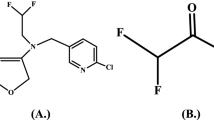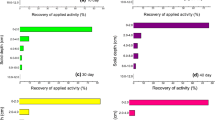Abstract
On percolating water equivalent to 1,156 mm of rainfall, spiromesifen formulation did not leach out of 25-cm long columns, and 62.7 % of this was recovered in 5–10-cm soil depth. In columns treated with the analytical grade, 52.40 % of the recovered spiromesifen was confined to 0–5-cm soil depth, with 0.04 % in leachate fraction, suggesting high adsorption in soil. Results revealed that percolating 400 mL of water, residues of enol metabolite of spiromesifen was detected up to 20–25-cm soil layer, with 23.50 % residues of spiromesifen in this layer and 1.73 % in the leachate fraction indicating that metabolite is more mobile as compared to the parent compound. Results suggested a significant reduction in leaching losses of enol metabolite in amended soil columns with 5 % nano clay, farmyard manure (FYM), and vermicompost. No enol spiromesifen was recovered in the leachate in columns amended with nano clay, vermicompost, and FYM; however, 85.30, 70.5, and 65.40 %, respectively, was recovered from 0–5 cm-soil depth of column after percolating water equivalent to 1,156 mm of rainfall. Spiromesifen formulation is less mobile in sandy loam soil than analytical grade spiromesifen. The metabolite, enol spiromesifen, is relatively more mobile than the parent compound and may leach into groundwater. The study suggested that amendments were very effective in reducing the downward mobility of enol metabolite in soil column. Further, it resulted in greater retention of enol metabolite in the amendment application zone.

Similar content being viewed by others
References
Black, C. A. (1965). Methods of soil analysis. Madison: American Society of Agronomy. 381.
Blecourt, M., Lahr, J., & Brick, P. J. (2010). Pesticide use in cotton in Australia, Brazil, India, Turkey and USA.
Cohen, S. Z., Creeger, S. M., Carsel, R. F., & Enfield, C. G. (1984). Potential pesticide contamination of groundwater from agricultural uses. In Treatment and disposal of pesticide wastes. ACS Symposium Series No. 259 (pp. 297–325). Washington, DC: American Chemical Society.
Das, S. K., & Mukherjee, I. (2012). Flubendiamide transport through packed soil columns. Bulletin of Environmental Contamination and Toxicology, 88, 229–233.
Das, S. K., & Mukherjee, I. (2014). Influence of microbial community on degradation of flubendiamide in two Indian soils. Environmental Monitoring and Assessment, 186, 3213–3219.
Graber, E. R., Gestle, Z., Fischer, E., & Mingelgrin, U. (1995). Enhanced transport of atrazine under irrigation with effluent. Soil Science Society of America Journal, 59, 1513–1519.
Gustafson, D. I. (2002). Groundwater ubiquity score: a simple method for assessing pesticide leachability. Environmental Toxicology and Chemistry, 8, 339–357.
Jackson, M. L. (1967). Soil chemical analysis (p. 204). New Delhi: Prentice Hall.
Johnson, R. M., & Pepperman, A. B. (1995). Mobility of atrazine from alginate controlled release formulations. Journal of Environmental Science and Health, Part B, 30, 27–47.
Jury, W. A., & Fluhler, H. (1992). Transport of chemicals through soil: mechanisms, models and field applications. Advances in Agronomy, 46, 141–201.
Karickhoff, S. W., Brown, D. S., & Scott, T. A. (1987). Sorption of hydrophobic pollutants on natural sediments. Water Research, 13, 241–248.
Lewis. D. H., & Cowsar, D. R. (1977). Principles of controlled release pesticides. In H. B. Scher (Ed.), Controlled release pesticides. Journal of the American Chemical society, 6, 1–16.
McMohan, M. A., & Thomas, G. W. (1979). Chloride and tritiated water flow in disturbed and undisturbed soil cores. Proceedings of the Soil Science Society of America, 38, 727–732.
Oygarden, L., Kvaerner, J., & Jenssen, P. D. (1997). Soil erosion via preferential flow to drainage systems in clay soils. Geoderma, 76, 65–86.
Regulatory Note RG2008-03. (2008). Publication coordinator, Pest Management Regulatory Agency, Health Canada, Ottawa, Canada. Available: www.hc-sc.gc.ca/pmra-arla.
Shasha, B. S., Doane, W. M., & Russell, C. R. (1976). Starch encapsulated pesticides for slow release. Journal of Polymer Science. Part B, 14, 417–420.
USEPA. (2010). Pesticide Fact Sheet, Flubendiamide. Office of Prevention, Pesticides & Toxic Substances. http://www.epa.gov/opprd001/factsheets/flubendiamide.pdf. Accessed 1 July 2010.
Verdezo, T. S., Undabeytia, T., & Nir, S. (2008). Environmentally friendly formulations of alachlor and atrazine: preparation, characterization, and reduced leaching. Journal of Agriculture and Food Chemistry, 56, 10192–10199.
Yousef, A. M., Young, J. L., & Freed, V. H. (1986). Binding of herbicides by water soluble organic material from soil. Journal of Environmental Quality, 15, 64–68.
Acknowledgments
The authors are grateful to the Director and Joint Director Research IARI, New Delhi-110012 for the support and for providing the facilities for the research work. Ch. Jamkhokai Mate is grateful to the Indian Agriculture Research Institute, New Delhi, for the financial assistance. Contribution No. 1145, Division of Agricultural Chemicals, IARI, New Delhi.
Author information
Authors and Affiliations
Corresponding author
Rights and permissions
About this article
Cite this article
Mate, C.J., Mukherjee, I. & Das, S.K. Mobility of spiromesifen in packed soil columns under laboratory conditions. Environ Monit Assess 186, 7195–7202 (2014). https://doi.org/10.1007/s10661-014-3920-5
Received:
Accepted:
Published:
Issue Date:
DOI: https://doi.org/10.1007/s10661-014-3920-5




